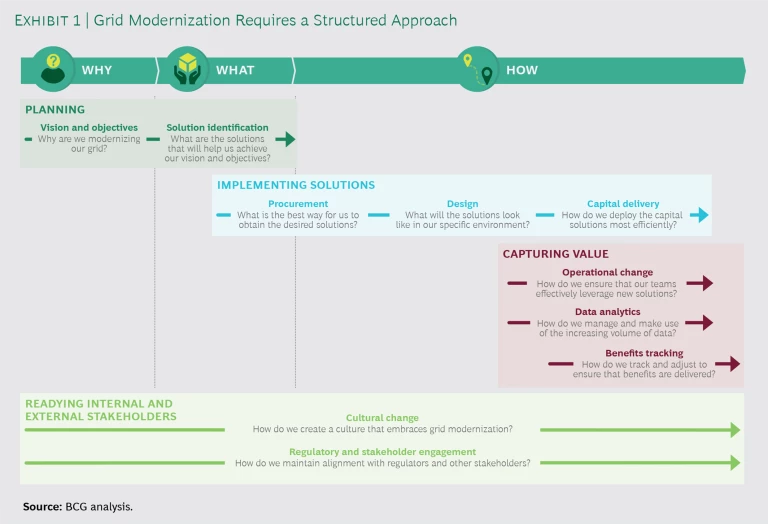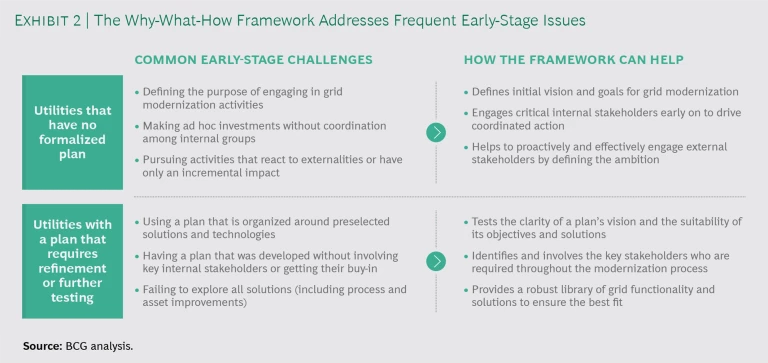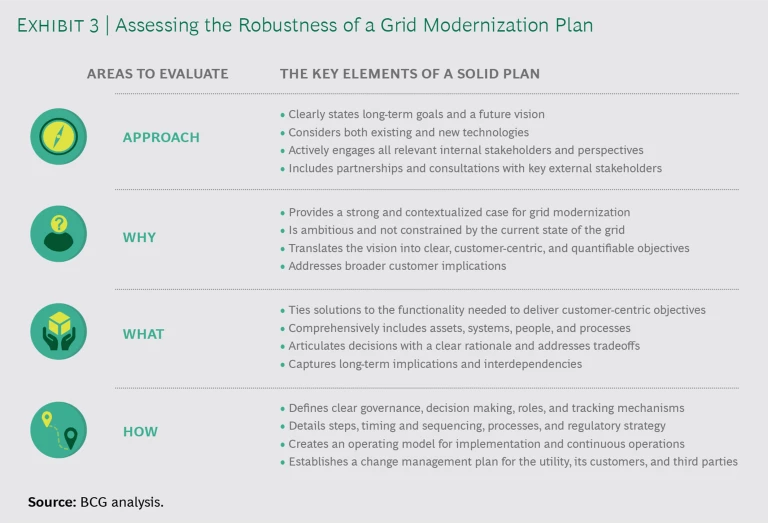Few utility executives doubt the urgent need to modernize their local electricity grid. Utility companies are facing myriad disruptive forces, including increasing regulation and a growing demand for data-driven services and distributed generation. And if companies have yet to see these forces fully play out in their own territories, they know that it’s only a matter of time before they do. To prepare, they need to build the power grid of the future today.
Modernizing a grid is a tough challenge, however. Since the beginning of 2018, at least five major utilities across the US have had grid modernization plans rejected by regulators because the proposals lacked a clear rationale for upgrading or failed to explain the benefits for the customer. Even when proposals gain regulatory approval, however, companies often struggle with the sheer complexity of the transformation required. For utilities that get it right, the benefits to the customer and company are considerable. Get it wrong, though, and the danger of falling further behind in a rapidly evolving energy landscape is significant.
A Why-What-How Framework
Most utilities that have difficulties modernizing their grid start with a single, all-encompassing question: How do we modernize our grid? As a result, these companies can get lost in the weeds of various technological solutions and fail to define what they are trying to achieve. Using a why-what-how framework, we help utilities break down the process into smaller components. (See Exhibit 1.) At the outset, companies set a vision and objectives by asking, Why are we modernizing our grid? This naturally leads to the next question: What are the solutions that will help us achieve our vision and objectives? After the what is defined, utilities are ready to address the how.
Applying this framework enables utility companies to approach modernization in a simpler, more structured way that is focused on value creation for all stakeholders . And using it in combination with our diagnostics and tools for grid modernization helps us to support companies wherever they are in their journey.
Two Common Scenarios
Utilities can face difficulties at any stage of grid modernization. In working with leading organizations, we commonly find one of two scenarios at those that are still in the early stages: A company may have made some initial grid investments, but it has yet to formulate a plan with a clear vision; or, a company has drafted a modernization plan, but it lacks the clarity, direction, and completeness needed to start selecting and implementing effective technologies and solutions.
Applying a why-what-how framework helps a company develop an effective modernization plan from scratch. The framework can also act as a stress test for an existing plan. By breaking the task of modernizing a grid into discrete phases, the framework helps companies tackle early-stage issues, such as making ad hoc investments without first coordinating internally or using a plan that is organized around preselected solutions. The framework helps tackle these challenges by ensuring greater clarity and unity of purpose, better agreement among internal and external stakeholders, and more effective execution from conception through delivery. (See Exhibit 2.)
Utilities without a grid modernization plan have the advantage of beginning with a clean slate, which means that they can more easily adopt the why-what-how framework. As a first step, a company should create a cross-functional team, with members from the strategy, IT, operations, and regulatory departments. This team will be responsible for creating a vision of the future grid, defining goals, securing buy-in from the leadership and key internal stakeholders, and selecting relevant solutions and technologies. For utilities at this stage, the framework can accelerate the planning and execution and ensure a comprehensive approach from day one.
Utilities that are further along—that have already drawn up a modernization plan—can use our diagnostic tool to assess its robustness so that problems are kept to a minimum. First, the tool scores a company’s current modernization plan in four areas: the approach taken (to ensure that the utility is tackling grid modernization in a way that is most relevant to its needs) and the three elements of the why-what-how framework. (See Exhibit 3.) The tool then compares the company’s scores with the scores of best-in-class modernization programs to identify gaps. If gaps exist, the company can address them using the framework. In this way, a company can be confident that it has a clear vision and objectives, that it has selected the best solutions and knows how to deploy them, and that it is ready to adapt its processes and human resources as required.
Tackling the Why and What of Grid Modernization
Developing a clear, coherent vision from the outset is essential for any grid modernization program to be successful. An effective vision defines a company’s aspirations, steers its strategic decisions for the next five to ten years, acts as a focal point for the modernization process, and unites internal and external stakeholders through shared goals.
But formulating a vision is not an easy task. The vision needs to address evolving customer demands and include quantifiable targets if it is to create value for customers and shareholders and pass muster with regulators. For example, a utility that wants to become a leading player in sustainability may have a vision to help expand the use of electric vehicles or increase distributed generation—and do so by a certain percentage. Similarly, a utility that is focused on grid reliability may aim to reduce the average duration of outages per customer by a specific amount of time.
BCG helps a company tackle the daunting vision challenge by identifying the critical customer trends that are likely to impact its businesses and by having one-on-one conversations with key stakeholders. Then we help the company define and refine a strong, unique vision that reflects the current regulatory environment and its overall strategy.
With a robust vision in place, utilities can identify the technologies and solutions that will enable them to reach their goals. Utilities can choose from a wealth of available options; a strong vision and quantifiable targets help companies choose the best solutions for their needs, avoid overspending, and gain the backing of stakeholders and regulators.
A strong vision and quantifiable targets help companies gain the backing of stakeholders and regulators.
To identify solutions, utilities should first determine the key functionalities that they need, such as real-time monitoring and power distribution planning. Then they can select the enabling solutions—including systems, processes, and people. Our experience enables us to help companies with both tasks. First, we help determine key functionalities. Second, we work to identify and procure the right commercial offerings or check that companies’ existing procurement decisions are the most appropriate ones. The objective is to ensure that companies select solutions that will help them achieve the targets set out in their vision. Finally, we perform a cost-benefit analysis to ensure that the solutions generate value for all stakeholders.
How to Execute a Plan Effectively
After focusing on the first two stages of grid modernization—the why and the what—we turn to the third stage: the how. This stage involves implementing solutions and capturing value, which requires changing how a company operates internally.
Grid modernization plans are typically made up of numerous initiatives, many of which need other initiatives to be completed first. Companies need to identify such interdependencies early on and implement related solutions together. Some high-level systems (such as a distributed energy resource management system that governs how distributed generation sources interface with the grid) will likely need to be put in place early so that other functionalities can be developed. If companies don’t identify interdependencies and adjust the implementation order for solutions, they may incur extra time and cost to redo an implementation or limit the potential benefits of a particular solution.
Companies risk incurring extra time and costs if they don’t identify the interdependencies among grid modernization initiatives.
Companies often fail to fully consider interdependencies, rely on poorly drafted plans to implement solutions and measure performance, or underestimate the magnitude of the cultural, behavioral, and business transformations required to succeed. BCG has developed an execution model to help companies address these challenges. It focuses on the following six areas that are key to executing an effective end-to-end grid modernization program:
- Governance and Decision Making. Companies need to create clear accountability for all decisions.
- Processes and Roles. Utilities will need to redesign some processes and give new responsibilities to individuals.
- Teaming and Organization. Companies should ensure that their organizational structure accommodates new business processes and solutions.
- Regulatory Management. Utilities should develop and implement a cohesive strategy that addresses regulatory requirements and outlines a plan for recovering investment costs.
- Culture and Behavior. Companies need to build a culture that ensures their employees’ actions match the organization’s vision.
- Performance Management. Utilities should use tools that track and measure execution and value creation at key milestones, ensuring that solutions are delivered effectively and provide measurable benefits for the company and its stakeholders.
What Success Looks Like
Utility companies that implement an effective grid modernization program can achieve significant cost savings, ease the process of regulatory approval, and secure greater buy-in from their stakeholders.
BCG supported a utility that was preparing a modernization plan and was significantly concerned about its quality and how it would be received by the local regulator. We worked with the company to develop a vision that would achieve the desired grid functionality, and we identified solutions to address gaps in the company’s plan. We recalculated the cost to ensure effective spending that delivered the required benefits and advised on testimony that supported the company’s filing. The revised plan more clearly and thoroughly defined the why and what of the program and, consequently, better fulfilled the regulator’s expectations. The proposed investments also received favorable reviews from national media outlets.
In another case, we worked with a major US utility operating across several states. The task was to develop a plan for investing in smart energy transmission and distribution systems while improving customer satisfaction and minimizing capital expenditures (both were requirements from the regulator). We started by defining stakeholder needs and creating a customer-driven vision for the grid of the future. Then we designed an investment and implementation program around the required functionality, supporting the company during solution selection, vendor negotiations, and execution planning. Our approach generated more than $200 million in savings for the company, the equivalent to 20% of its total spending, through improved program execution.
Modernizing a grid is not easy, and the potential pitfalls are many. Despite the complexity of the task, utility companies are under increasing pressure to implement the technologies and solutions that will make their grid fit for the future—and to do it fast. To meet the expectations of customers, stakeholders, and regulators, companies should not delay in getting a systematic, manageable approach to modernization underway.












